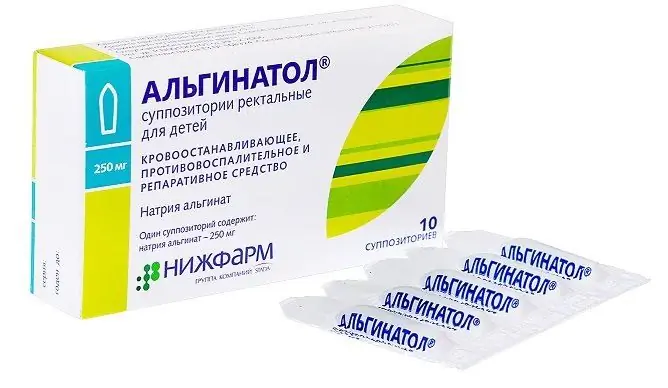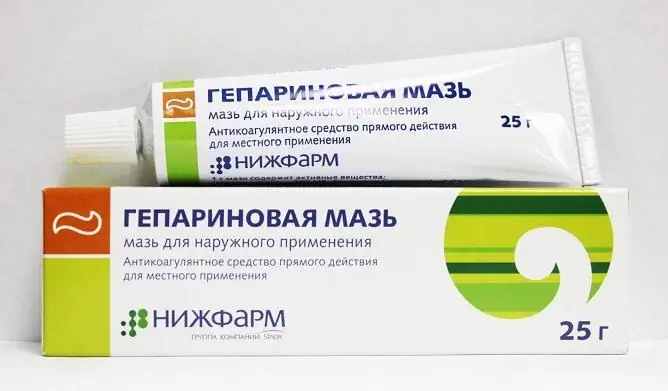- Author Rachel Wainwright [email protected].
- Public 2023-12-15 07:39.
- Last modified 2025-11-02 20:14.
Levomekol for hemorrhoids: reviews, instructions for use, action
The content of the article:
- Composition and mechanism of action
- Instructions for the use of Levomekol ointment for hemorrhoids
- Can Levomekol be used during pregnancy and lactation
- Possible side effects
- Contraindications
- Forms of release and storage conditions
Levomekol for hemorrhoids is used along with other local remedies - rectal suppositories, ointments, gels, medicinal baths. Local therapy consists in the effect of drugs directly on the hemorrhoids. At the same time, drugs practically do not enter the systemic circulation, which means that they are not able to have any negative effect on the body.
Levomekol ointment has been used in surgery for many years and has proven itself in the treatment of purulent wounds. It also effectively helps with hemorrhoids.

Levomekol ointment has anti-infectious and anti-inflammatory effect
A huge number of microorganisms live in the intestine, and especially in the rectum. Getting on the damaged walls of hemorrhoids, they cause purulent inflammation, which can spread to the pararectal tissue and lead to the development of complications (paraproctitis, fistula). The therapeutic effect of Levomekol ointment for hemorrhoids is primarily due to its powerful antibacterial effect, which is provided by the antibiotic chloramphenicol, which is part of the drug. However, it is precisely because of this component that the use of the ointment can be accompanied by the development of complications. Therefore, despite the fact that the drug is sold in pharmacies in non-prescription departments, it should not be used without consulting a doctor.
Composition and mechanism of action
Levomekol ointment for hemorrhoids has a complex effect, due to the fact that it contains several active components:
- Levomycetin (chloramphenicol). A broad-spectrum antibiotic, that is, it inhibits the growth and development of most bacteria, chlamydia, spirochetes and rickettsia. Aerobic and anaerobic microorganisms (Staphylococcus spp., Streptococcus spp., Clostridium perfringens) are sensitive to it. Resistance to chloramphenicol in microbes develops very slowly, so it retains its bactericidal activity even with repeated use. It is also important that when applied topically, the antibiotic does not have a toxic effect on the body.
- Methyluracil. The substance stimulates tissue regeneration, has a wound healing effect. In addition, it mildly stimulates local immunity, thereby suppressing the activity of inflammation.
- Ethylene glycol. Provides removal of dead cells.
All these components potentiate (enhance) each other's action. As a result, Levomekol ointment from hemorrhoids has the following effect:
- antibacterial - inhibits the growth and development of pathogenic microflora, which causes inflammation of hemorrhoids and surrounding tissue;
- wound healing - methyluracil enhances the synthesis of nucleic acids and protein by cells of the rectal mucosa, which contributes to the speedy healing of its damage;
- adsorbing - cleansing the ulcerated surface of hemorrhoids from the products of purulent fusion, which creates good conditions for tissue regeneration;
- anti - inflammatory - reduces the severity of the inflammatory process, thereby quickly eliminating swelling, itching, burning and pain in the anus;
- dehydrating - dries the wound surface, thereby creating favorable conditions for the healing of wound defects (this action is associated with polyethylene oxides, which are the basis of the ointment).
Instructions for the use of Levomekol ointment for hemorrhoids
The main indication for prescribing the drug for hemorrhoids is inflammation of the hemorrhoids.
Before using the ointment, a thorough toilet of the genitals and perineum is performed. After washing, the area around the anus is dried with a soft towel with gentle dabbing movements. Then the required amount of ointment is applied to a gauze napkin and distributed over it. A napkin with ointment is applied to the anus and left for several hours. It is most convenient to carry out this procedure in the evening, just before going to bed - since it is impossible to fix the napkin in the correct position and during the day, with active movement, it will move. The duration of the course of treatment is determined by the doctor.
In case of internal hemorrhoids or the presence of a deep anal fissure, the ointment is heated to 35-36 ° C and a small cotton-gauze swab is well saturated with it, which at the base should be firmly tied with a bandage. This tampon is carefully inserted into the ampoule of the rectum and left there for 3-4 hours, after which it is removed by pulling on the bandage. This method of application is not always convenient in practice, therefore, proctologists with internal hemorrhoids usually prescribe ready-made rectal suppositories with a similar effect (for example, Methyluracil suppositories) to patients, which are much easier to use.
How to use Levomekol against hemorrhoids in one case or another (applications, tampons), the doctor will tell you.
Can Levomekol be used during pregnancy and lactation
Hemorrhoids during pregnancy are very common; according to various estimates, 60-80% of pregnant women suffer from them in one form or another. If left untreated, it will progress, leading to the development of serious complications that may require surgical intervention. However, the choice of drugs during pregnancy is limited, as they can negatively affect the development of the fetus.
The ointment contains the antibiotic chloramphenicol. Even with topical application, the possibility of its penetration into the systemic circulation and into breast milk is not excluded. Despite the extremely small amount of the drug that can penetrate the fetus during gestation and into breast milk, its complete safety in this case has not been proven. Therefore, the use of Levomekol for hemorrhoids in pregnant women and during breastfeeding is not recommended. But in cases where the benefits of the drug significantly outweigh the possible risks, the doctor may prescribe it to pregnant and lactating women.
Possible side effects
Reviews about Levomekol from hemorrhoids from both specialists and patients are mostly positive, the drug has a quick and pronounced therapeutic effect. Side effects when using it are rare, but not completely excluded. Sometimes Levomekol can cause the development of the following undesirable conditions:
- a change in the cellular composition of the blood due to a decrease in the level of erythrocytes (erythrocytopenia) and leukocytes (leukocytopenia) - the risk of development increases with a long course of treatment;
- allergic reactions (urticaria, allergic dermatitis, eczema) - develop in patients with individual intolerance to one or another component of the ointment.
With the development of side effects, the drug should be discontinued, the doctor should be notified of this, who will adjust the therapy.
When using Levomekol ointment, it is necessary to strictly adhere to the recommendations for the use of the ointment, the timing of treatment.
Contraindications
The use of Levomekol ointment is contraindicated in the following cases:
- individual intolerance;
- fungal infection of the skin and mucous membranes at the site of application of the ointment;
- psoriatic plaques in the area of application.
Forms of release and storage conditions
Levomekol ointment is available in metal tubes containing 25, 30 or 40 g.
The storage conditions are not regulated by the manufacturer. This means that the ointment can be stored at room temperature out of the reach of children.
Available from pharmacies without a doctor's prescription.
YouTube video related to the article:

Elena Minkina Doctor anesthesiologist-resuscitator About the author
Education: graduated from the Tashkent State Medical Institute, specializing in general medicine in 1991. Repeatedly passed refresher courses.
Work experience: anesthesiologist-resuscitator of the city maternity complex, resuscitator of the hemodialysis department.
Found a mistake in the text? Select it and press Ctrl + Enter.






